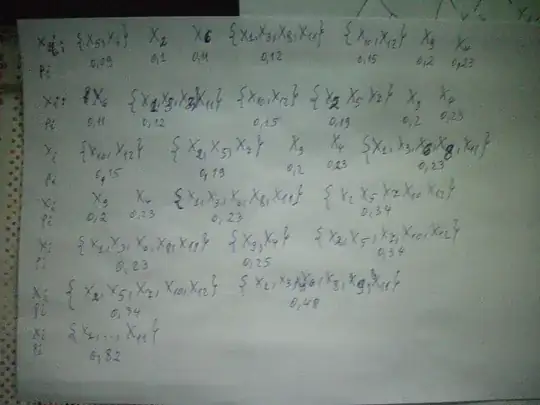Just follow the algorithm: combine the least frequent pair, and keep doing so. Here the least frequent are $X_1$ and $X_{11}$; they combine to make a new node $\{X_1,X_{11}\}$ with weight $0,01+0,02=0,03$. Now your list of nodes looks like this, after I reorder it by weight:
$$\begin{array}{rcc}
X_i:&X_8&\{X_1,X_{11}\}&X_7&X_5&X_3&X_{10}&X_{12}&X_2&X_6&X_9&X_4\\
p_i:&0,03&0,03&0,04&0,05&0,06&0,07&0,08&0,1&0,11&0,2&0,23
\end{array}$$
The smallest two are $X_8$ and $\{X_1,X_{11}\}$, so we combine them to make a new node $\{X_1,X_8,X_{11}\}$ of weight $0,03+0,03=0,06$, and we now have the following list:
$$\begin{array}{rcc}
X_i:&X_7&X_5&X_3&\{X_1,X_8,X_{11}\}&X_{10}&X_{12}&X_2&X_6&X_9&X_4\\
p_i:&0,04&0,05&0,06&0,06&0,07&0,08&0,1&0,11&0,2&0,23
\end{array}$$
Now combine $X_7$ and $X_5$ to make a node $\{X_5,X_7\}$ of weight $0,09$, reducing the list to this:
$$\begin{array}{rcc}
X_i:&X_3&\{X_1,X_8,X_{11}\}&X_{10}&X_{12}&\{X_5,X_7\}&X_2&X_6&X_9&X_4\\
p_i:&0,06&0,06&0,07&0,08&0,09&0,1&0,11&0,2&0,23
\end{array}$$
The next step combines $X_3$ with $\{X_1,X_8,X_{11}\}$, and the one after that combines $X_{10}$ and $X_{12}$ to produce the list
$$\begin{array}{rcc}
X_i:&\{X_5,X_7\}&X_2&X_6&\{X_1,X_3,X_8,X_{11}\}&\{X_{10},X_{12}\}&X_9&X_4\\
p_i:&0,09&0,1&0,11&0,12&0,15&0,2&0,23
\end{array}$$
At this stage your your graph looks like this:
* * * * * * *
/ \ X2 X6 / \ / \ X9 X4
/ \ / \ / \
X5 X7 * * X10 X12
X3 / \
/ \
* *
/ \ X8
/ \
* *
X1 X11
Can you finish it now? Just keep on doing the same thing until it becomes a single tree. There are seven separate pieces now, so that will take six more steps. Once you have the tree, we can worry about how to get the actual Huffman code from it.
Added: There are two possible trees; here’s a rough sketch of one of them.





